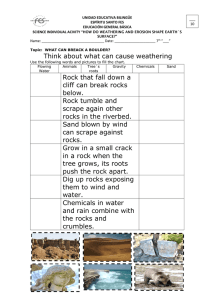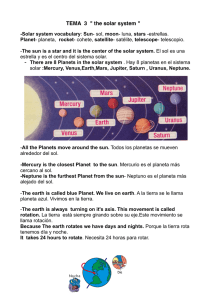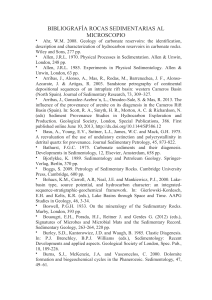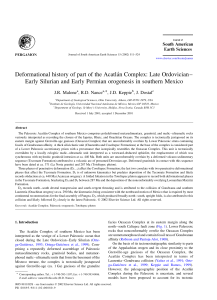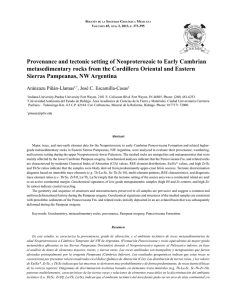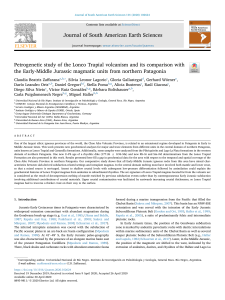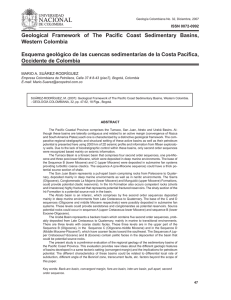geochemistry and provenance of pre
Anuncio
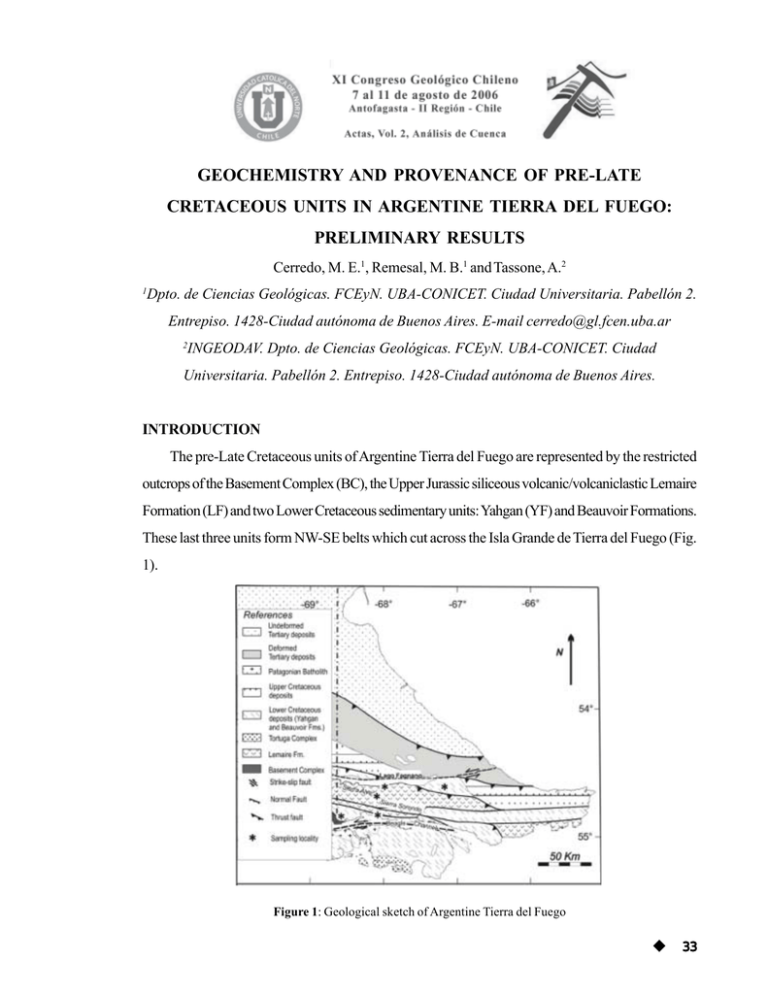
TOMO 1 - Análisis de Cuencas GEOCHEMISTRY AND PROVENANCE OF PRE-LATE CRETACEOUS UNITS IN ARGENTINE TIERRA DEL FUEGO: PRELIMINARY RESULTS Cerredo, M. E.1, Remesal, M. B.1 and Tassone, A.2 1 Dpto. de Ciencias Geológicas. FCEyN. UBA-CONICET. Ciudad Universitaria. Pabellón 2. Entrepiso. 1428-Ciudad autónoma de Buenos Aires. E-mail cerredo@gl.fcen.uba.ar 2 INGEODAV. Dpto. de Ciencias Geológicas. FCEyN. UBA-CONICET. Ciudad Universitaria. Pabellón 2. Entrepiso. 1428-Ciudad autónoma de Buenos Aires. INTRODUCTION The pre-Late Cretaceous units of Argentine Tierra del Fuego are represented by the restricted outcrops of the Basement Complex (BC), the Upper Jurassic siliceous volcanic/volcaniclastic Lemaire Formation (LF) and two Lower Cretaceous sedimentary units: Yahgan (YF) and Beauvoir Formations. These last three units form NW-SE belts which cut across the Isla Grande de Tierra del Fuego (Fig. 1). Figure 1: Geological sketch of Argentine Tierra del Fuego " 33 XI CONGRESO GEOLOGICO CHILENO The BC (made up of very low- to low-grade metamorphic rocks in Argentina) was interpreted as the Late Paleozoic to Early Mesozoic accretionary wedge formed along the western Panthalassic margin of Gondwanaland later metamorphosed and uplifted prior to the Late Jurassic (Dalziel 1982). LF comprises the acid volcanic and interlayered volcaniclastic rocks evolved in the extensional tectonic regime which led to the formation of the Rocas Verdes back-arc Basin (RVB). The Lower Cretaceous units represent the infilling of the RVB with detritus source areas located either in the Southern magmatic arc -YF- or in the northern margin of the basin –Beauvoir Fm.- (Olivero and Martinioni, 2001). GEOCHEMISTRY Studied samples of the BC come from the limited ouctcrops of Bahía Ensenada and Lapataia at the SW (Fig. 1), LF samples belong to the fine-grained sedimentary facies of B.Ensenada and outcrops of the central NW-SE belt, YF rocks correspond to the lowermost facies of fine-grained turbidites (Olivero and Martinioni, 1996) and the Beauvoir Fm. rocks (LKM) were sampled in central Tierra del Fuego to the SE of Lago Fagnano (Figure 1). Based on major and trace element data preliminary results are presented. Th/U vs. U diagram (Mc Lennan et al., 1993) provides a tool for estimation the weathering of sedimentary rocks, given that there is a tendency for an elevation of Th/U ratios above upper crustal values of 3.5-4 as a result of alteration. Only the group of LKM (Fig. 2) displays a slight weathering trend, the remainder show no evidence of weathering with Th/U ratios below the canonical upper crustal value of 3.8 (McLennan et al., 1990). COMPOSITION The Zr/Ti vs Nb/Y diagram (Winchester and Floyd, 1977) provides a broad estimation of the composition of (meta)sedimentary rocks. The LKM from central Tierra del Fuego display very limited Nb/Y and Zr/Ti variations and plot within the dacite/rhyodacite field. The LF rocks show larger spread within the same compositional field. The YF and BC samples, in turn, scatter from the andesite to dacite/rhyodacite fields (Fig. 3). 34 " TOMO 1 - Análisis de Cuencas Figure 2: Th/U vs. Th after McLennan et al. (1993) displaying low degrees of weathering. YF= Yahgan Fm.; BC=Basement Complex; LF= Lemaire Fm.; KLM= Lower Cretaceous Mudstones. Figure 3: Zr/Ti vs. Nb/Y plot to indicate the general composition of the (meta)sedimentary rocks. Abbreviations as in Fig. 2 RARE EARTH ELEMENTS Samples show mainly a typical upper continental crust composition regarding REE. When normalized to PAAS (Post-Archean Average Australian shale after Nance and Taylor, 1976; Fig. 4) average values for each unit display smooth negative Eu anomaly (0.87 for LF samples), negligible positive Eu anomaly (1.06 for LKM) or moderate positive Eu anomalies both for YF (1.3) and BC (1.29) rocks. Figure 4: Average REE patterns normalized to PAAS. Abbreviations as in Fig. 2 Figure 5: Th/Sc vs. Zr/Sc after McLennan et al. (1990). " 35 XI CONGRESO GEOLOGICO CHILENO PROVENANCE HFSE (i.e. Th, Sc, Zr) and REE are useful for provenance studies as they are insoluble and generally immobile under surface conditions, therefore they preserve characteristics of the source rocks (Taylor and McLennan, 1985, Bathia and Crook, 1986, McLennan et al., 1993). The Th/Sc vs. Zr/Sc diagram (Fig. 5) allows inferring two main compositional sources for the studied units. A more evolved one represented by LKM and LF with Th/Sc ratios close to the upper crustal average, and a less fractionated source for YF and BC, characterized by lower Th/Sc ratios. No significant crustal recycling may be interpreted for any of the studied units. The influence of a less fractionated source for YF and BC might be also interpreted from their low Th/Sc (Fig. 5) and Th/U ratios (Fig. 2). On the basis of available chemical data it is not possible to distinguish distinct provenance components for YF and BC. Both units share some common interelemental ratios (i.e.: La/Th>2.8, low Th/Sc, low LaN/SmN, smooth Eu/Eu*CN) which suggest mafic sources in the provenance. Moreover, there is a striking overlapping in the average REE patterns of both units (Fig. 4). LKM and LF show higher Th/Sc (0.5-0.9), LaN/SmN, lower La/Th (1.8-2.8) and more pronounced Eu/Eu*CN which point to a more felsic provenance, but higher Th/U of LKM (4.4-4.7) suggests a slight degree of weathering in comparison with LF which displays lower Th/U ratios (2.83.3) pointing to some mafic component in the provenance. REFERENCES Bathia, M. R. and Crook, K.A.W. 1986. Trace element characteristics of greywackes and tectonic setting discrimination of sedimentary basins. Contributions to Mineralogy and Petrology, 92: 181-193 Dalziel, I. W. D. 1982 The early (pre-middle Jurassic) history of the Scotia arc region: a review and progress report. In Craddock, C. (ed) Antarctic Geoscience: 111-126 McLennan, S. M., Taylor, S. R., McCulloch, M. T. and Maynard, J. B. 1990 Geochemical and Nd-Sr isotopic composition of deep-sea turbidites: Crustal evolution and plate tectonic associations. Geochimica et Cosmochimica Acta, 54: 2015-2050 Mc Lennan, S. M., Hemming, S., McDaniel, D. K. and Hanson, G. N., 1993. Geochemical approaches to sedimentation, provenance and tectonics- In: Johnsson, M. J. and Basu, A. (eds.): Processes controlling the composition of clastic sediments. Geological Society of America, Special Publication 284: 21-40 Nance, W. B. and Taylor, S. R., 1976 Rare earth element patterns and crustal evolution – I. Australian PostArchean sedimentary rocks. Geochimica et Cosmochimica Acta, 40: 1539-1551 Olivero, E. B. and Martinioni, D. R. 2001. A review of the geology of the Argentinian Fuegian Andes. Journal of South American Earth Sciences 14: 175-188 Olivero, E. B. and Martinioni, D. R. 1996. Sedimentología de las Formaciones Lemaire y Yahgán (JurásicoCretácico) en Tierra del Fuego. XIII Congreso Geológico Argentino 2: 45-59 Taylor, S. R. and McLennan, S. M., 1985 The continental crust: its composition and Evolution. Blackwell, 312 pp Winchester, J. A. and Floyd, P. A. 1977. Geochemical discrimination of different magma series and their differentiation products using immobile elements. Chemical Geology, 20: 325-343 36 "
